What will happen to President Obama’s current and future judicial nominees if Republicans take over the Senate? Indeed, what will happen even if they don’t?
As reported in the New York Times, Obama’s circuit nominees have changed the party-of-appointing-president balance among active status judges on the 13 courts of appeals; only four now have a majority of Republican appointees. He has also changed the aggregate make up—Democratic appointees now occupy 95 (53%) of the 179 statutorily created circuit judgeships. Republican appointees have the edge (53%) among all 282 circuit judges, although senior status judges (who, as semi-retirees, don’t occupy statutorily created judgeships) rarely carry the full caseload of active status judges and some carry none at all. (Among district judges, who are not the focus of this post, Democratic appointees occupy 50% of the 675 authorized judgeships, and of all 1,064 sitting judges, active and senior.)
The following brief observations about how court of appeals confirmations might change the balance on those courts in the next two years are prefaced by the caveats that party-of-appointing-president is a better predictor of judicial decisions in some areas than in others; not every appointee of any president was a member of his party; and the three-judge panels that almost always speak for the court sometimes include senior judges and judges temporarily assigned from other courts.)
For background: This table summarizes the composition of the courts of appeals (CAs) by presidential administration. The data on the left denote the composition of CAs at the starts of Presidents Clinton’s, Bush’s, and Obama’s terms, signifying CAs with Democratic-appointee majorities and the aggregate party-of-appointment breakdown among active judges. The data on the right side denote, over the course of each president’s term, the number of circuit appointees, confirmation rates, and, of those appointees, how many replaced appointees of the other party.
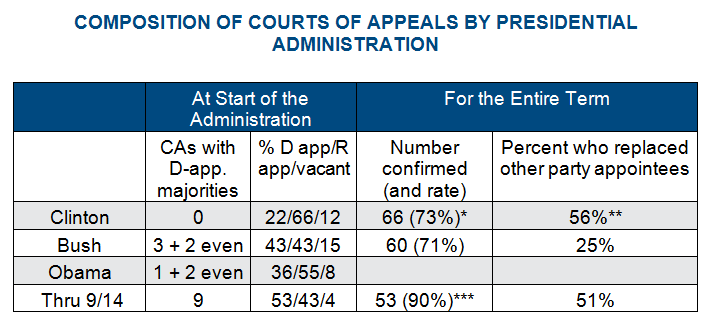
*–Figures show the Fourth Circuit’s Roger Gregory (recess appointed late in Clinton’s term then renominated by Bush early in his) as a Democratic appointee.
**–Clinton was also able to fill 6 new seats created in 1990 but not filled in the Bush 1 administration.
***–Obama’s confirmation rate would probably stand at 80% had the filibuster rule not changed, as explained here.
President Clinton inherited an appellate judiciary heavily dominated by Republican appointees after the 12 Reagan-H.W. Bush years. By the end of his term (and thus the start of President George W. Bush’s), he increased the Democratic-appointee-majority courts from none to three, and the percent of Democratic-appointees in the 179 judgeships by 21 points from 22% to 43%.
Bush was less successful, reducing the Democratic-appointed majority courts from three to one, and decreasing the percentage of Democratic appointees by only seven points, to 36%. Clinton was more successful in part because he had slightly more confirmations, but mainly because 56% of those confirmations put judges into seats formerly held by Republican appointees, and he was also able to fill six new seats. By contrast, only 25% of Bush’s appointees replaced Democratic appointees.
Obama, near the end of his sixth year, has appointed 53 circuit judges (a figure unlikely to change in 2014: none of the seven current vacancies has a nominee). Those 53 appointees are three more than Bush had through 2006, although quite likely six and without doubt three confirmations were due to the filibuster rule change. And, because half of his appointees replaced Republican appointees, he has been able to raise the proportion of Democratic appointees in the 179 judgeships to 53%.
If Democrats Keep the Senate:
The questions will be how many more circuit vacancies will occur and how many of them will be created by Republican appointees. A lame-duck president would still have a filibuster-proof Senate, although home-state senators will retain the “blue slip veto” over nominees.
Consider this speculation:
- The courts of appeals currently have eight vacancies (including one announced for next February). Five were created by Republican appointees. If Obama were to fill all eight, the four courts of appeals with Republican-appointee majorities would keep them, although one, in the Seventh Circuit, would move from a 7-3 breakdown (with one vacancy) to a slim 6-5 Republican-appointee majority. The proportion of Democratic appointees nationally would rise to 58%.
- Currently, 57 active-status circuit judges are eligible to take senior status (are 65 or older and years of service plus age total 80) and thus create that many more vacancies. (Fifteen more will be eligible by 2016.) If—beyond the eight filled vacancies—four of the current 29 senior-eligible Republican appointees take senior status, and Obama were able to replace all four, it would shift the current 53%-43% Democratic-Republican-appointee breakdown (with four percent vacant) to a 60% Democratic-appointee majority (assuming, for analysis, no more vacancies). It could also shift the balance on two courts of appeals (e.g., if he replaced two of Fifth Circuit’s six senior-eligible Republican appointees and one of the five in the Seventh Circuit).
Obviously, the more Republican appointees who leave active service, creating vacancies for a filibuster-proof Senate to fill, the more the balance on courts of appeals will change. Being senior-eligible and actually taking senior status, though, are two different things. Twenty of the 57 senior-eligible judges have been eligible for some time (born before 1940 and appointed in the 1970s or 1980s). There is no reason to think all of them, or younger senior-eligible judges, will suddenly leave active status in the next two years. The conjecture above, moreover, doesn’t (and couldn’t) anticipate the handful of vacancies that could result from active status judges’ deaths, resignations, or appointments to the Supreme Court.
And, the blue-slip rule will still be in place, keeping a veto power over nominations in the hands of home-state senators. None of the eight current or announced vacancies has a nominee. All but one (the newest, on the Federal Circuit) are in states with at least one Republican senator. For those seven, the average time from date of announcement is 582 days, and two are near or over 1,000 days.
If Republicans Take the Senate:
In addition to the imponderables above, the lame-duck president’s party will lose control of the confirmation machinery in an already highly polarized atmosphere. Those words, however, perhaps with a little less polarization, describes the final two years of recent eight-year presidencies. Confirmations slowed down but hardly stopped.

If the Senate in 2015-16 were to add proportionately as many circuit judges to Obama’s 2014 total as the Senate added in 2007-08 to Bush’s 2006 total, it would confirm 10 or eleven more judges, for a total of 63 or 64. But that’s a big “if.”
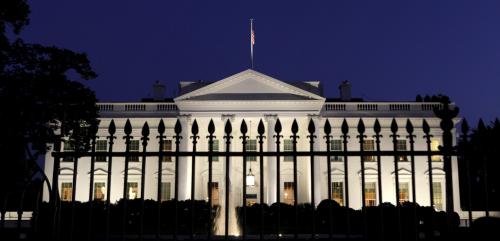

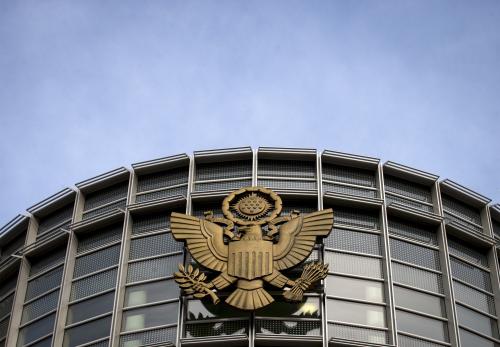
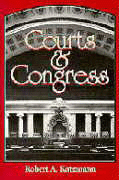
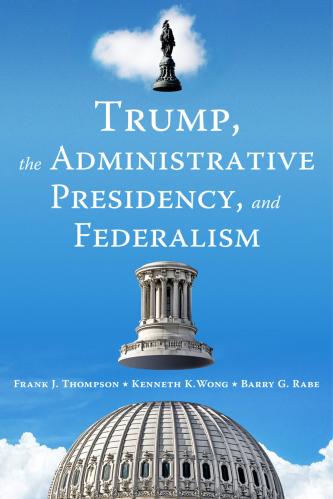





Commentary
Speculating About Obama’s Judicial Confirmations in the Next Congress
September 19, 2014